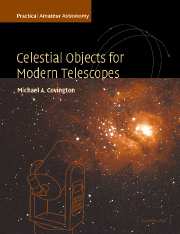Book contents
- Frontmatter
- Contents
- Preface
- Part I Amateur astronomy
- 1 Using this book effectively
- 2 Observing sites and conditions
- 3 The Moon, the Sun, and eclipses
- 4 The planets
- 5 Comets, asteroids (minor planets), and artificial satellites
- 6 Constellations
- 7 Stars – identification, nomenclature, and maps
- 8 Stars – physical properties
- 9 Double and multiple stars
- 10 Variable stars
- 11 Clusters, nebulae, and galaxies
- Part II 200 interesting stars and deep-sky objects
- Appendices
- Index
11 - Clusters, nebulae, and galaxies
Published online by Cambridge University Press: 22 September 2009
- Frontmatter
- Contents
- Preface
- Part I Amateur astronomy
- 1 Using this book effectively
- 2 Observing sites and conditions
- 3 The Moon, the Sun, and eclipses
- 4 The planets
- 5 Comets, asteroids (minor planets), and artificial satellites
- 6 Constellations
- 7 Stars – identification, nomenclature, and maps
- 8 Stars – physical properties
- 9 Double and multiple stars
- 10 Variable stars
- 11 Clusters, nebulae, and galaxies
- Part II 200 interesting stars and deep-sky objects
- Appendices
- Index
Summary
The lure of the deep sky
The “deep sky” is the sky beyond the Solar System, and while it theoretically includes all stars except the Sun, in practice “deep-sky observing” means observing star clusters, nebulae, and galaxies.
For many amateur astronomers, including myself, deep-sky observing is the most interesting specialty, the most far-ranging form of celestial sightseeing. We bought our telescopes in order to see the universe. For the variety of sights and the variety of astrophysical processes behind them, deep-sky observing is unsurpassed.
Critics point out that deep-sky observers are unlikely to contribute anything to science, since most of the objects are near the limit of visibility in amateur telescopes, and apart from occasional supernovae in distant galaxies, there is nothing that amateur equipment can discover. That doesn't deter us. Seeing the sights is enough.
Deep-sky objects
Asterisms
An asterism is any small group of stars that catches the eye, whether or not the stars form a cluster in space. M73, for instance, is an asterism of four stars in Aquarius.
In recent years, amateur astronomers have given colorful names to numerous telescopic asterisms, many of which were enumerated by Philip S. Harrington in The Deep Sky: An Introduction (Sky Publishing, 1998). That book is actually an excellent overall guide to deep-sky observing and includes a small but useful star atlas. I must confess to having subsequently named two asterisms myself, Webb's Horseshoe (p. 207) and the Perfect Right Angle (p. 245).
Information
- Type
- Chapter
- Information
- Celestial Objects for Modern TelescopesPractical Amateur Astronomy Volume 2, pp. 144 - 164Publisher: Cambridge University PressPrint publication year: 2002
